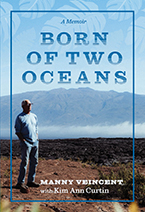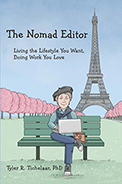May 15, 2025
Born of Two Oceans: A Memoir
Manuel Veincent with Kim Ann Curtin
IngramSpark (2025)
ISBN: 979-8-218-62452-1 (paperback)
ISBN: 979-8-218-62453-8 (ebook)
Hawaiian “Saltwater Cowboy” Tells His Fascinating Life Story
 Manuel Veincent, known as “Uncle Manny” to those who have had the good fortune of knowing him, has led a fascinating life that encompasses and embodies a great deal of Hawaiian history, the true aloha spirit, and a lot of grit and determination. Now, in his memoir, Born of Two Oceans, Veincent shares his experiences, from his very traditional Hawaiian upbringing in the 1930s and 1940s, to his years fighting in the Korean War, his experiences ranching, beginning a canoe club in Hawaii, and his years working for the fire department. This book is not only a celebration of the life of an extraordinary man, but a work that captures important cultural and historical details that will make you feel like you’ve come to know Hawaii very well, even if you’ve never been there.
Manuel Veincent, known as “Uncle Manny” to those who have had the good fortune of knowing him, has led a fascinating life that encompasses and embodies a great deal of Hawaiian history, the true aloha spirit, and a lot of grit and determination. Now, in his memoir, Born of Two Oceans, Veincent shares his experiences, from his very traditional Hawaiian upbringing in the 1930s and 1940s, to his years fighting in the Korean War, his experiences ranching, beginning a canoe club in Hawaii, and his years working for the fire department. This book is not only a celebration of the life of an extraordinary man, but a work that captures important cultural and historical details that will make you feel like you’ve come to know Hawaii very well, even if you’ve never been there.
Uncle Manny has an inner strength or toughness most of us would envy. He clearly inherited some of this fortitude from his grandparents. His description of his childhood is colorful and unforgettable, and his grandparents, known as Tutu Man and Tutu Lady, were at the heart of it. He describes how tough his grandfather was. This was a man who smoked Bull Durham raw tobacco and consequently had bad lungs and coughed all the time, yet when Manny went fishing with him, he would be amazed by how the old man could hold his breath underwater and walk on the ocean floor to lay his traps. In another story, his grandfather leaves the hospital on his second day there and walks the long distance home, despite the doctor saying he needs to stay for a couple of weeks.
Manny’s childhood reflects a simpler time when there was a large sense of community. Friends and relatives would come to visit, and they would all sleep in the house on the floor. They would share their meals and the fish they caught. There were no TVs and not even toys except those you made. People spent time talking and sharing and really living in a way that is almost forgotten now. They also ate healthy, fresh food, often what they caught or picked that very day.
Hawaii and its history is at the center of the book. Manny reflects on the wrongs done by the United States to the Hawaiians, but also how present and future generations can help to right it. He is a believer in traditional beliefs and shares many interesting stories of how nature has at times had its revenge when people have tried to abuse its natural resources. One short but fascinating story is:
“In the 1960s, in Hilo while working for the Hawaii Fire Department, I went to pick maile (vines used to make leis) on a day off. Four of us entered the forest off a road in Panaewa Forest. About 150 feet from the road, we ran into a loaded quarter-acre patch of fragrant maile growing from the ground. It was just like a garden, like it was cultivated and cared for. Four of us helped ourselves. Maile leis were made on the spot. We decided to come back in two days and harvest more maile. We marked the trail with orange ribbons—every ten feet. It was a perfect, well-marked trail. Two days later, we went back to the same spot. Same orange ribbons. No maile. Only wild uluhe fern. My grandfather always told me, “Don’t be greedy. Take just what you need. Leave some for others.”
Manny shares his entire life story from his school experiences with other Hawaiian kids and haole (white) teachers to joining the Marines during the Korean War after high school, his experiences overseas and how the Marines taught him discipline, his courtship of his wife, “Aunty Eunice,” his time attending what is now the University of Hawaii, and his various careers, including working for the airlines, the State, in Fire and Rescue, and ranching.
To me, one of the most impressive parts of Manny’s early adult life was when he worked for the State of Hawaii and was part of the Nene Restoration Program. The nene is the Hawaiian goose and the state bird of Hawaii. It had come close to extinction, its population being down to just thirty in 1952. Today, while the population has grown to more than 3,800, it is still the world’s rarest goose. During his time working for the program, Manny lived in the mountains to observe and capture the birds for the breeding program. He documented their flight movements, numbers, and nests. It is fair to say that without his efforts, the nene might have gone extinct.
Manny also became very interested in ranching, first helping to operate his wife’s aunt’s ranch. Today, he has his own small ranch of 300 acres. He almost single-handedly runs the ranch, doing all the work despite being in his nineties, but he also gets friends and family members to come help him, especially during branding time. In the ranching chapter, he shares stories of trying to break in difficult horses, his experiences working with the small but strong local Filipinos, and how the mountains and ranching speak to a part of his soul that brings him peace and comfort.
But Uncle Manny is perhaps best known for his role as coach of the Kawaihae Canoe Club, which began in 1972. He was involved in its creation and served as its president from 1982 to 2023. More specifically, he is an amazing coach who has taught generations of members not only how to paddle in sync with one another and win races, but to believe in themselves and their abilities. Countless people have been taken under his wing and transformed as a result.
While most of the book is told in Manny’s voice, he had help from one of those paddling mentees, Kim Ann Curtin. Besides interviewing Manny to create this book, she has interviewed many of those who have known and loved him through the years, and they share their own stories of how Manny helped them, or just funny stories of Manny’s antics and sly humor. The stories are too long to detail here, but believe me, you want to read them. Mike Field, a celebrated waterman and gifted artist, calls Manny a “saltwater cowboy” because of his combined love of ranching and paddling. All those interviewed have been involved with him in those two activities.
Truly, Manny Veincent is that rare man who is comfortable in his own shoes and comfortable in diverse situations. He has created a tremendous legacy for paddlers, Hawaiians, and now readers. I am so grateful that he and Kim Ann Curtin have captured his story and memories in these pages. I’m a firm believer that everyone has something interesting to say, but Manny stands practically alone in having many interesting and diverse things to say because he has lived so many various lives and yet seems completely balanced in who he is.
— Tyler R. Tichelaar, PhD and award-winning author of Narrow Lives and Spirit of the North

